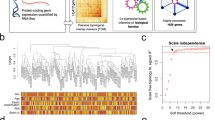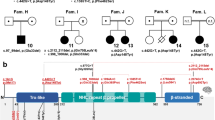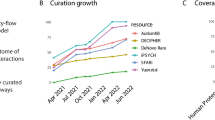Abstract
Autosomal recessive cutis laxa is a genetically heterogeneous condition. Its molecular basis is largely unknown. Recently, a combined disorder of N- and O-linked glycosylation was described in children with congenital cutis laxa in association with severe central nervous system involvement, brain migration defects, seizures and hearing loss. We report on seven additional patients with similar clinical features in combination with congenital disorder of glycosylation type IIx. On the basis of phenotype in 10 patients, we define an autosomal recessive cutis laxa syndrome. The patients have a complex phenotype of neonatal cutis laxa, transient feeding intolerance, late closure of the fontanel, characteristic facial features including down-slanting palpebral fissures, short nose and small mouth, and developmental delay. There is a variable degree of the central nervous system involvement and variable systemic presentation. The biochemical analysis using transferrin isoelectric focusing gives false negative results in some of the youngest patients. Analysis of the apolipoprotein C-III isoelectric focusing, however, is diagnostic in all cases.
Similar content being viewed by others
Log in or create a free account to read this content
Gain free access to this article, as well as selected content from this journal and more on nature.com
or
References
Hashimoto K, Kanzaki T : Cutis laxa. Ultrastructural and biochemical studies. Arch Dermatol 1975; 111: 861–873.
Reisner SH, Seelenfreund M, Ben-Bassat M : Cutis laxa associated with severe intrauterine growth retardation and congenital dislocation of the hip. Acta Paediatr Scand 1971; 60: 357–360.
Hucthagowder V, Sausgruber N, Kim KH, Angle B, Marmorstein LY, Urban Z : Fibulin-4: a novel gene for an autosomal recessive cutis laxa syndrome. Am J Hum Genet 2006; 78: 1075–1080.
Loeys B, Van Maldergem L, Mortier G et al: Homozygosity for a missense mutation in fibulin-5 (FBLN5) results in a severe form of cutis laxa. Hum Mol Genet 2002; 11: 2113–2118.
Biver A, De Rijcke S, Toppet V, Ledoux-Corbusier M, Van Maldergem L : Congenital cutis laxa with ligamentous laxity and delayed development, Dandy–Walker malformation and minor heart and osseous defects. Clin Genet 1994; 45: 318–322.
Van Maldergem L, Ogur G, Yuksel M : Facial anomalies in congenital cutis laxa with retarded growth and skeletal dysplasia. Am J Med Genet 1989; 32: 265.
Gruenewald S, Matthijs G, Jaeken J : Congenital disorders of glycosylation: a review. Pediatr Res 2002; 52: 618–624.
Wopereis S, Gruenewald S, Morava E et al: Apolipoprotein C-III isofocusing in the diagnosis of genetic defects in O-glycan biosynthesis. Clin Chem 2003; 49: 1839–1845.
Morava E, Wopereis S, Coucke P et al: Defective protein glycosylation in patients with cutis laxa syndrome. Eur J Hum Genet 2005; 13: 414–421.
Wopereis S, Morava E, Gruenewald S et al: A combined defect in the biosynthesis of N- and O-glycans in patients with cutis laxa and neurological involvement: the biochemical characteristics. Biochim Biophys Acta 2005; 1741: 156–164.
Morava E, Willemsen MA, Wopereis S et al: High myopia and congenital myopathy with partial pachygyria in cutis laxa syndrome. Eur J Ophthalmol 2006; 16: 190–194.
Beltran-Valero de Bernabe D, Currier S, Steinbrecher A et al: Mutations in the O-mannosyltransferase gene POMT1 give rise to the severe neuronal migration disorder Walker–Warburg syndrome. Am J Hum Genet 2002; 71: 1033–1043.
van Reeuwijk J, Janssen M, van den Elzen C et al: POMT2 mutations cause alpha-dystroglycan hypoglycosylation and Walker–Warburg syndrome. J Med Genet 2005; 42: 907–912.
van Reeuwijk J, Brunner HG, van Bokhoven H : Glyc-O-genetics of Walker–Warburg syndrome. Clin Genet 2005; 67: 281–289.
Wopereis S, Morava E, Gruenewald S et al: Patients with unsolved congenital disorders of glycosylation type II can be subdivided in six distinct biochemical groups. Glycobiology 2005; 15: 1312–1319.
Wopereis S, Gruenewald S, Huijben KM et al: Transferrin and apolipoprotein C-III isofocusing are complementary in the diagnosis of N- and O-glycan biosynthesis defects. Clin Chem 2007; 53: 180–187.
Woods CG, Cox J, Springell K et al: Quantification of homozygosity in consanguineous individuals with autosomal recessive disease. Am J Hum Genet 2006; 78: 889–896.
Kornak U, Reynders E, Dimopoulou K et al: Mutations in the a2-subunit of the v-type H+-ATPase impair glycosylation in the Golgi apparatus and cause autosomal recessive cutis laxa type 2, 2007. Nature Genetics, in press.
Elahi E, Kalhor R, Banihosseini SS et al: Homozygous missense mutation in fibulin-5 in an Iranian autosomal recessive cutis laxa pedigree and associated haplotype. J Invest Dermatol 2006; 126: 1506–1509.
de Barsy AM, Moens E, Dierckx L : Dwarfism, oligophrenia and degeneration of the elastic tissue in skin and cornea. A new syndrome? Helv Paediatr Acta 1968; 23: 305–313.
Wu X, Steet RA, Bohorov O et al: Mutation of the COG complex subunit gene COG7 causes a lethal congenital disorder. Nat Med 2004; 10: 518–523.
Morava E, Zeevaert R, Korsch E et al: A common mutation in the COG7 gene with a consistent phenotype including microcephaly, adducted thumbs, growth retardation, VSD and episodes of hyperthermia. Eur J Hum Genet 2007; 15: 638–645.
Acknowledgements
This work was supported by grants from EUROGLYCANET contract number 512131 and NIH grants HL073703 and HL084922. We are thankful for the support of H van Bokhoven, M Janssen, A Vogt and L Berendsen regarding the linkage and sequence analysis.
Author information
Authors and Affiliations
Corresponding author
Rights and permissions
About this article
Cite this article
Morava, E., Lefeber, D., Urban, Z. et al. Defining the phenotype in an autosomal recessive cutis laxa syndrome with a combined congenital defect of glycosylation. Eur J Hum Genet 16, 28–35 (2008). https://doi.org/10.1038/sj.ejhg.5201947
Received:
Revised:
Accepted:
Published:
Issue date:
DOI: https://doi.org/10.1038/sj.ejhg.5201947
Keywords
This article is cited by
-
A novel deletion mutation in the ATP6V0A2 gene in an Iranian patient affected by autosomal recessive cutis laxa
Irish Journal of Medical Science (1971 -) (2023)
-
Polymicrogyria and myoclonic epilepsy in autosomal recessive cutis laxa type 2A
neurogenetics (2016)
-
Clinical and biochemical features guiding the diagnostics in neurometabolic cutis laxa
European Journal of Human Genetics (2014)
-
Glycosylation defects underlying fetal alcohol spectrum disorder: a novel pathogenetic model
Journal of Inherited Metabolic Disease (2012)



